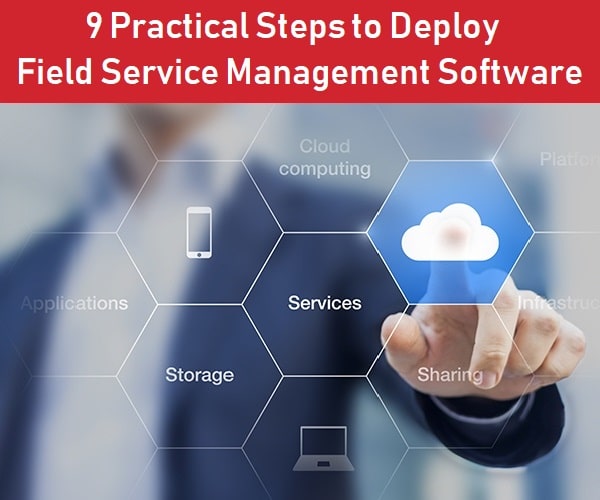
- Field Service Management
- Mobile App
- cloud-based
Cloud vs on-premise: The better choice for service businesses
Understanding On-Premise and Cloud Solutions: The Basics
In the current era of digital transformation, businesses are increasingly faced with critical decisions regarding their IT infrastructure. Specifically, the choice between on-premise and cloud-based solutions often takes center stage. Understanding the distinctions and implications of these two deployment methodologies is key to making informed decisions that serve the best interests of your business.
On-Premise Solutions: A Closer Look at Control and Customization
On-premise solutions represent the traditional approach to IT infrastructure. This model entails hosting all necessary software and hardware within the company’s physical location, often in a dedicated server room.
The primary advantage of on-premise solutions is the level of control and customization they afford. Companies can fine-tune their system configuration to meet their unique requirements, effectively creating a tailored solution. They have full control over their data, from the storage processes to the security measures employed, and do not have to depend on a third-party service provider.
However, this increased control and customization come with substantial costs and responsibilities. The initial outlay for equipment, software licenses, and setting up server rooms can be significant. Moreover, the company is responsible for the employment of experienced IT personnel to manage and maintain the system. Regular system maintenance and updates can also pile up additional costs over time, making on-premise solutions a potentially pricey option.
Cloud Solutions: Exploring the Benefits of Flexibility and Scalability
Cloud solutions, in contrast, leverage remote servers typically owned and managed by third-party providers. Users access their systems and data via the internet, which eliminates the need for substantial hardware investments on-site.
The cloud model offers considerable benefits in terms of flexibility and scalability. Businesses can quickly adjust their system usage based on their needs, scaling up during periods of high demand or scaling down during slower periods. Such flexibility is particularly beneficial for businesses with fluctuating or seasonal demands.
Additionally, cloud solutions often operate on a subscription-based pricing model, which can be more cost-effective than the substantial upfront costs associated with on-premise systems. However, as businesses rely on third-party providers for data management and storage in the cloud model, there can be concerns about data privacy, control, and potential vendor lock-in.
On-Premise vs Cloud: Key Aspects to Consider
When comparing on-premise vs cloud solutions, several factors should be evaluated to make an informed decision.
1. Cost Considerations
The financial implications of the choice between on-premise and cloud are crucial. On-premise solutions often require substantial capital expenditure (CapEx) at the outset, including costs for hardware, software, installation, and setting up the necessary infrastructure. Additionally, there will be ongoing operational expenditure (OpEx) for system maintenance, updates, and possible upgrades.
On the other hand, cloud solutions typically operate on a pay-as-you-go or subscription model. This model allows for predictable recurring expenses without substantial upfront costs. However, over a long period, the recurring costs can add up and may eventually surpass the one-time investment of an on-premise solution.
2. Security and Compliance
Security is a paramount concern for businesses, especially those handling sensitive data. Both on-premise and cloud solutions have distinct security advantages and challenges.
On-premise solutions offer complete control over data security, but the responsibility for maintaining high security standards and compliance lies entirely with the business. This task includes updating firewalls, patch management, and securing the system against evolving threats.
In the case of cloud solutions, businesses rely on the cloud provider’s security measures. These are typically robust and are updated continuously to combat emerging cyber threats. However, the business has less control over security in this scenario and could be indirectly affected by security breaches at the provider’s end.
3. Accessibility and Collaboration
In today’s increasingly globalized and mobile business landscape, accessibility of data and systems is critical. Here, cloud solutions often have the upper hand. Cloud-based systems can be accessed from any location with an internet connection, enabling remote work and enhancing collaboration among geographically dispersed teams.
On-premise solutions, however, may restrict data access to the local network. Remote access, if available, usually requires a secure Virtual Private Network (VPN), which can add complexity and potential bottlenecks to the system.
4. Scalability and Agility
In terms of scalability and agility, cloud solutions are typically superior. These solutions are designed to allow rapid changes in capacity to accommodate growth or contraction. Conversely, scaling up on-premise solutions may necessitate additional hardware or software purchases and installation, which takes more time and investment.
Making the Choice: On-Premise vs Cloud
There’s no one-size-fits-all solution in the on-premise vs cloud debate. The right choice depends on numerous factors, including your business needs, financial capacity, growth plans, and comfort level with data control and security.
Some businesses opt for a hybrid model that blends the benefits of both on-premise and cloud solutions. This model allows critical data to be stored on-premise for control and security, while other functions take advantage of the flexibility of the cloud.
1. System Updates and Maintenance
With an on-premise solution, your IT department takes care of updates and maintenance. While this gives your company more control over the timing and nature of updates, it also places the entire responsibility on your staff. Furthermore, if your IT department doesn’t have the necessary expertise or resources, the system could be at risk.
Cloud solutions, in contrast, are updated and maintained by the service provider. This generally ensures that your systems are always running the latest versions and that any problems are quickly addressed by experts. However, you may have less control over when updates happen, which can sometimes result in unexpected downtime.
2. Disaster Recovery and Business Continuit
Business continuity and disaster recovery are crucial elements to consider when choosing between on-premise and cloud solutions. On-premise environments require your business to implement and manage its own backup and recovery solutions. This can be time-consuming and costly, but it does give you complete control over your data and how it’s protected.
Cloud solutions, on the other hand, often include disaster recovery services as part of the package. Data is typically backed up to multiple locations, which can provide robust protection against data loss. However, the recovery process will depend on the service provider, and in the event of a major outage, you may have to wait for the provider to restore services.
3. Long-Term Strategic Fit
Finally, it’s essential to consider how each solution fits into your company’s long-term strategies. If your business anticipates significant growth, cloud solutions can offer the scalability needed to accommodate this. If you operate in an industry with strict data security regulations, the control offered by on-premise solutions might be a better fit.
Hybrid solutions can also align well with future strategies, offering a balance between the control of on-premise solutions and the flexibility and scalability of the cloud.
Conclusion: The Future is Hybrid
The on-premise vs cloud debate is not about picking one over the other; it’s about finding the right balance for your business needs. Many businesses are finding that a hybrid model offers the best solution, combining the strengths of both on-premise and cloud solutions.
A hybrid infrastructure allows businesses to keep sensitive data and critical applications on-premise, while still leveraging the scalability and cost-effectiveness of cloud-based solutions for less sensitive tasks. This approach not only balances control and flexibility but also allows for future adjustments as business needs and technology landscapes evolve.
In conclusion, the optimal IT infrastructure for your business depends on your unique requirements, budget, and future plans. By understanding the pros and cons of on-premise vs cloud solutions, you can make an informed decision that supports your business’s growth and success in the long term.
Our similar articles.
-
- Field Service Management
- scheduling software
- Service Technician
Service Technician Scheduling Software: How to Get More Hours Back in Your Day
August 8, 2023 -
- Software
- Field Service Management
- Maintenance
9 Practical Steps to Deploy Field Service Management Software
July 19, 2018 -
- Field Service Management
- Maintenance
- Gestion d’interventions
- HVAC
Why maintenance for air conditioners is increasingly important
June 8, 2022


